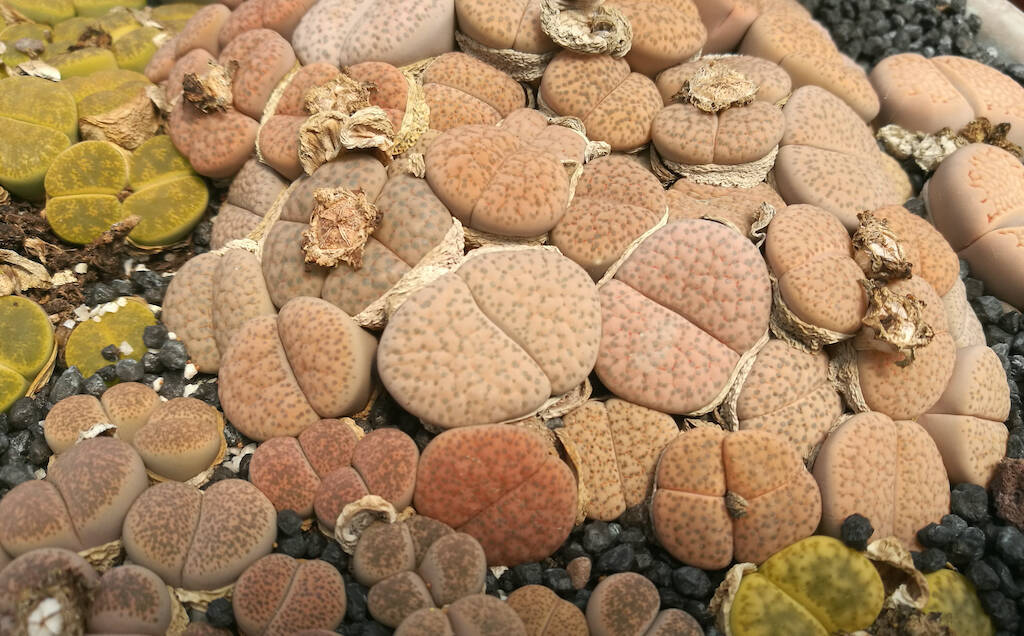Also known as “stone plants” or “living stones”, Lithops are a genus of succulents that are always highly appreciated and widespread in cultivation and in collections. These are actually small plants, very particular, aesthetically pleasing and available in an infinite variety of colors and shades. Speaking of Lithops, one thing must be clarified immediately: they are non-cacti succulents. In other words, these plants do not belong to the large Cactaceae family (which includes cacti), but to the Mesembryanthemaceae family. In reality, according to many authors, to date the Mesembryanthemaceae family does not even exist anymore and the genera once attributable to it must be included in the Aizoaceae family. This vast family of succulent plants includes many other genera often widespread in cultivation or in nature also in Europe, such as Carpobrotus, Conophytum, Delosperma, Faucaria, Fenestraria, Lapidaria , Oscularia, Pleiospilos, Titanopsis and Trichodiadema.
Let’s deepen our knowledge of the Lithops genus in this article, in which we will also see the particular cultivation regime that these plants need in order to live in the Northern hemisphere. (…)
Description
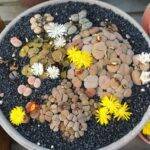
Among the genera belonging to the Mesembryanthemaceae (or Aizoaceae according to the classification currently accepted by the majority of researchers), that of the Lithops is certainly among the most full-bodied in terms of number of species and at the same time among the most appreciated in cultivation. These are dwarf plants, ie small even in adulthood, coming from semi-desert areas of southern Africa, in particular from the areas of Namibia and South Africa. The “living stones” are called by Giuseppe Lodi in his splendid volume “Le mie piante grasse” (Edagricole). And “living stones” or “living rocks” is the definition to which we often see these plants associated, due to their flat, rounded appearance, with colors and superior design capable of perfectly reproducing small stones, with which in nature they are camouflage on the soils of origin. On the other hand, the same scientific name indicates this characteristic, being derived from the Greek lithos, i.e. pebble/stone, and opsis, i.e. “appearance”.
Each plant is formed by a pair of fleshy leaves, joined at the base of the short conical stem and clearly separated by a slit at the apex, which is flat and with rounded edges, overall ovoid in shape. If along the sides the stem and the leaves have a uniform colour, which varies from species to species from green to reddish to grey/blue, the upper part of the leaves, i.e. the one that receives light and stores it for photosynthesis, is covered by thin veins (in some cases there are punctiform spots) and rich in shaded colours, these too vary according to the species. The stem is almost completely underground: the plants emerge from the ground for a few millimeters and the upper face of the two leaves has a sort of “window”, i.e. an area without chlorophyll and therefore able to filter the light and let it penetrate inside the plant. The root system develops at the end of the cone which forms the stem and branches off from a fleshy root, dividing into not particularly long peripheral roots. Overall, however, between the stem and the root system, the plant grows several centimeters deep and it will therefore be a good idea to use deep pots for cultivation.
The flowers
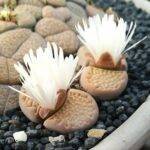
Lithops blooms are never abundant: generally one or two flowers at a time, but if we grow these plants in bowls, side by side, we will have a beautiful spot of color during flowering, which in our latitudes (Northern hemisphere) occurs in autumn roughly between the end of October and the beginning of November. The flowers emerge from the crack between the two leaves and are always white or yellow, reminiscent of daisies and open in the afternoon. In this regard, what Lodi notes is interesting: “The difference in color of the flowers is often accompanied by a difference in the shape of the bodies. In the very young plants of Lithops with yellow flowers (…) the fissure between the two lobes does not cross the entire upper face; in those with white flowers (Leucolithops) the fissure crosses the entire upper face” (Giuseppe Lodi, “Le mie piante grasse”, ed. Edagricole).
The moult of the leaves
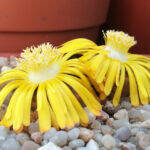
A peculiar feature of these plants is the moulting of the leaves, which can occur in variable periods (in any case during the winter in the northern hemisphere) depending on the species and age of the plant. It is through the moult that the plant, in fact, is “reborn” and perpetuates itself. The old leaves dehydrate to get completely dry; at the same time, a new pair of leaves begins to form from the buried stem. As they grow, the new leaves will literally break the old ones, which will have collapsed in the meantime. Once the new ones have formed, the old leaves will dry out completely and can be detached by simply pulling them gently with your fingers (operation to be done only when the leaves are completely dry!). Of fundamental importance is not to water the plant while the moult is in progress. In this phase the Lithops do not absorb water and the new leaves feed on the liquids accumulated inside the stems. Watering would be equivalent to soaking the soil so that it remains wet for a long time (in part because the moult takes place in winter and the humidity does not evaporate due to the low temperatures, in part because in this phase the plant does not drink), with consequent triggering of the rot that would lead the plant to death.
Cultivation
The cultivation of these plants requires particular and distinct precautions compared to those required by cacti or other succulents. Overall, however, Lithops are not difficult to grow, provided you know their needs.
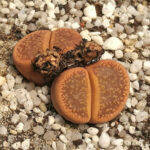
The soil must be very poor and draining. You can use a third of clayey field earth mixed with fine sand to which we will add a third of pumice and a third of quartzite (that for aquariums is fine). Alternatively, we can reduce the part of clay a little to add a small organic component (peat or earthworm humus). Lodi advised, for these plants, a substrate composed of three parts of sand, two of clay and one of leaf mold. As far as exposure is concerned, Lithops need plenty of light, even direct sun if they are used to it, for most of the day. In this way they will maintain the compact shape of the stem and the leaves will not lengthen, ending up protruding a few centimeters from the soil, as happens in incorrectly cultivated specimens.
The waterings can be abundant but it is good to reduce them and wait for the substratum to dry completely between one watering and another, also because these succulents are particularly sensitive to humidity and can rot easily if the soil is not correct. On the contrary, like many other Mesembryanthemaceae, they tolerate long periods of drought without problems, so in case of doubt, the advice is always to not water and let more time pass before giving water.
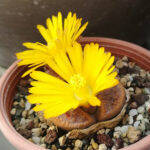
As a rule, let’s say that in the Northern hemisphere the Lithops are watered exclusively from May to all of October, reducing the watering in the central months (July and August) to suspend them completely in November: in fact, they should be watered from when the moult is completed until the plants slow down to face the winter. During the winter months it is not entirely certain that these plants go into stasis, as happens for example with cacti. It is probable that, even if they stop absorbing water, the plants work on moulting in the underground part. No problem with low temperatures: if kept perfectly dry from the end of October, Lithops can winter even at five or six Celsius degrees below zero.
Reproduction
Lithops can be reproduced by cuttings or by division of the tufts, but the most used method is sowing, which follows the rules common to cacti. The seeds are rather small and the undertaking can prove inconvenient for the less experienced, but overall it does not present particular difficulties.
Species and varieties
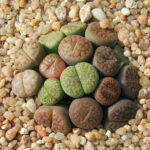
There are dozens of species attributable to the genus Lithops and even more varieties. Only an expert eye is able to distinguish one species from another or a variety from a cultivar. The design on the leaf surface can help, as well as the color of the plant and its nuances, but the undertaking, for those who are not experts, remains quite difficult. Among the most common and widespread species we should mention the aucampie, the karasmontana, the lesliei, the optica and the pseudotruncatella. As for the colors you are spoiled for choice and there is no shortage of bright green Lithops (once very difficult to find) or blue, gray, brick red or purplish.
SUBSCRIBE TO THE SITE – If you liked this article, subscribe to the site to have access to all the contents for one year or three months depending on the formula you choose. Here you will find terms and conditions.
SUBSCRIBE TO THE NEWSLETTER – If you want to receive the free newsletter every time new content is published (even if you have not subscribed to the site), fill in the fields at this link!
Correlated articles
Succulent plants
Substrates for cacti and succulents
Watering succulents
Classification of succulents
© The texts, videos, photos and graphic elaborations of the site “Il fiore tra le spine” are original material and are covered by copyright. It’s forbidden to reproduce them in any way.


